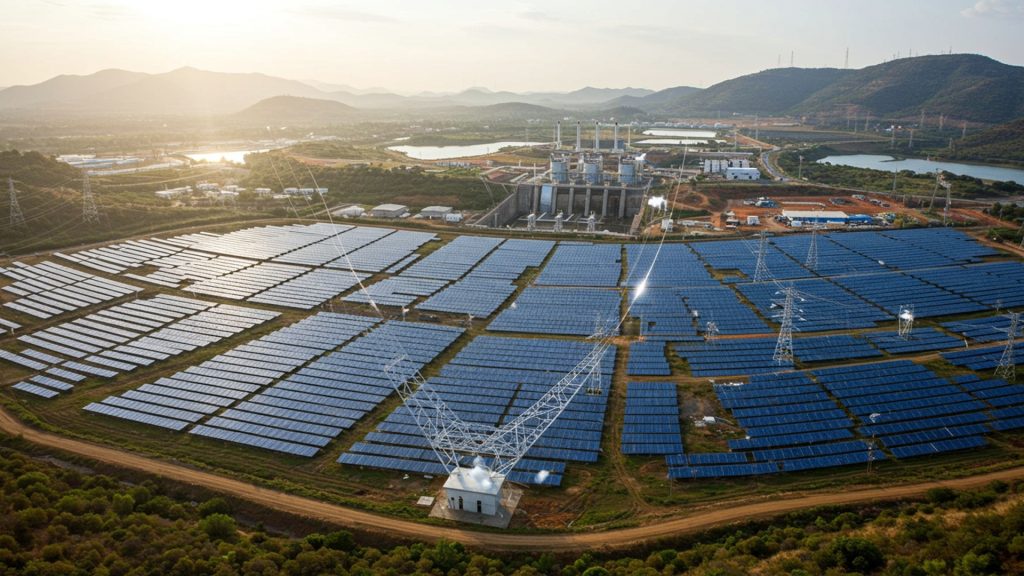Andhra Pradesh’s power utility today reveals a massive ₹28,000 crore plan for its Green Energy Corridor Phase III, marking a big step in the state’s drive for clean power. This huge project aims to build a wide network to move vast amounts of energy from solar and wind farms across the region. The move makes sure more homes and businesses will get steady, green electricity. It puts Andhra Pradesh at the front of India’s push for renewable energy, promising a future powered by clean, sustainable sources.
Push for Clean Energy Grows
Andhra Pradesh, a state in India, has taken a big step towards a greener energy future. The state’s main power utility has put forward plans for the third part of its Green Energy Corridor, a major project that aims to bring more clean power to homes and businesses. This new phase is expected to cost around ₹28,033 crore. The plan has been sent to the Central Electricity Authority for approval. This move is part of the state’s larger goal to add much more green energy to its power system in the coming years.
What the New Project Will Do
The third phase of the Green Energy Corridor in Andhra Pradesh is a very crucial part of the state’s efforts to increase its use of clean energy. The project is designed to connect a large amount of solar power and pumped storage hydropower projects to the existing power grid. Specifically, it aims to link 11 Gigawatts (GW) of solar power and 7,373 Megawatts (MW) of pumped storage hydropower. This will involve building new power lines and stations. The plan includes setting up 8,862 circuit kilometers of new transmission lines and adding an extra 9,500 MVA of power capacity.
A key reason for this new project is to solve a challenge related to where green energy is made and where it is needed. Most of the state’s potential for renewable energy, like solar and pumped storage, is found in the Rayalaseema region. But, the demand for power is growing quickly in the coastal areas. These coastal areas are seeing the rise of new industries, including green hydrogen centers and large data centers. To make sure the power gets to where it is needed, the project proposes a special Extra High Tension (EHT) transmission network. This network will connect the energy production zones in Rayalaseema with the coastal areas that have high demand.
Understanding the Green Energy Corridor Plan
The Green Energy Corridor is a big project launched by the Government of India. Its main purpose is to connect electricity made from renewable sources, such as solar, wind. hydro power, with the traditional power grid. The goal is to make the power grid work better, ensure the country has enough energy. send extra clean energy from states that produce a lot of it to states that need more power.
The idea for the Green Energy Corridor came from a study in 2012 by the Power Grid Corporation of India Limited (PGCIL). This study showed that the existing power setup was not ready for a big increase in renewable energy. Following this, a detailed plan for the Green Energy Corridor was put together and the project officially began in 2015. The Ministry of New and Renewable Energy plays a central role in guiding this project.
The project is happening in different parts, or phases. The first phase started in 2015-16. It covered eight states that are rich in renewable energy. Andhra Pradesh was one of them. The aim of this national project is to use India’s large potential for renewable energy and build the necessary infrastructure to bring that power into the national grid system. This excess energy can then be sent to states that do not have enough power.
The entire Green Energy Corridor project has several essential goals. It aims to reduce India’s carbon footprint, which means lowering the amount of harmful gases released into the air. It also helps in creating energy solutions that are good for the environment and can last a long time. Finishing this project will help India make sure it has enough energy for the future and meets its growing energy needs. It also helps the country reach its target of having 450 Gigawatts of power from non-fossil fuel sources by 2030, a goal that shows India’s commitment to cleaner energy.
How the Project Will Be Paid For
The large cost of ₹28,033 crore for the third phase of the Green Energy Corridor in Andhra Pradesh will be covered by a standard way of funding used for such projects across India. This funding model involves different sources to ensure the project gets the money it needs.
First, the central government will provide a grant. This grant, which comes from the Ministry of New and Renewable Energy, will cover 40 percent of the total cost of the project. This shows the central government’s support for clean energy projects in states.
Second, another 40 percent of the project’s cost will come from loans. This money will be borrowed to help pay for the building and setup of the new power lines and stations.
Finally, the remaining 20 percent of the cost will be covered by an equity contribution from the Power Grid Corporation of India. This means the Power Grid Corporation will invest its own money into the project, showing its involvement and commitment to the Green Energy Corridor initiative.
This combined approach to funding helps ensure that major clean energy projects like this can move forward, with support from both central and state bodies, along with financial institutions.
Expected Benefits for the State and Country
The Green Energy Corridor Phase III project is expected to bring many benefits to Andhra Pradesh and contribute to India’s overall clean energy goals. A main outcome will be the state’s ability to support India’s clean energy targets for the year 2030. By improving its power infrastructure, Andhra Pradesh will play a vital role in the country’s move towards more sustainable energy.
This project will help reduce India’s carbon footprint, leading to cleaner air and a healthier environment. It also encourages the creation of energy solutions that are friendly to the environment and can be used for a long time. The new infrastructure will also make the power grid more stable and reliable, meaning fewer power outages and more steady electricity supply.
Beyond environmental benefits, the project is also expected to create many job opportunities. Such a large infrastructure project needs both skilled and unskilled workers, leading to employment in the renewable energy sector. It will also attract more investments into the clean energy field, further boosting the state’s economy.
Andhra Pradesh has set an ambitious goal to produce 72 GW of green energy by 2029. This project is a big step towards reaching that target. The state has also launched India’s first Integrated Clean Energy Policy in 2024, with the aim of becoming a ‘Net Zero’ state by 2047. This policy is designed to bring in about ₹4. 56 lakh crore in investments and create 4. 09 lakh jobs.
Already, Andhra Pradesh Power Transmission Corporation (APTRANSCO) has shown good progress in managing its power system. They have managed to bring down transmission losses from 2. 69% to 2. 60% in 2024-25. They have also put into service nine new substations, which added 4,905. 5 MVA of capacity. Moreover, the state’s power distribution companies have reduced their distribution losses from 7. 23% to 7. 07% and overall technical and commercial losses from 13% to 8%.
Under the PM-KUSUM scheme, solar-powered systems are being set up for over 2. 93 lakh agricultural water pumps. Also, rooftop solar panels have been installed in 39,863 homes through the PM Surya Ghar Muft Bijli Yojana.
Who is Involved in the Project
Many crucial groups and individuals are involved in making the Green Energy Corridor Phase III project a reality in Andhra Pradesh. The main state power utility, Andhra Pradesh Power Transmission Corporation (APTRANSCO), has taken the lead in preparing and submitting the detailed plans for this project. Andhra Pradesh Power Generation Corporation Limited (APGENCO) is also a key player, working on major hydro and pumped storage projects that will feed into this corridor.
The proposals for this phase were submitted to the Central Electricity Authority (CEA), which is a central government body responsible for planning and coordinating power development in the country. Their review and approval are essential for the project to move forward. The Ministry of New and Renewable Energy (MNRE) at the central level provides significant financial support through grants for Green Energy Corridor projects.
The Power Grid Corporation of India (PGCIL) is another major stakeholder, involved in the overall national Green Energy Corridor initiative and contributing equity to the project’s funding.
crucial officials have also been closely involved. Andhra Pradesh Chief Minister N. Chandrababu Naidu has pushed for this project as part of the state’s broad clean energy goals. Kirthi Chekuri, the Joint Managing Director for Human Resources and Administration at APTRANSCO and a Member-Convenor of the Andhra Pradesh Power Coordination Committee, announced the submission of the final proposals. She highlighted the vital work done by the power sector employees, calling them the backbone of the state’s electricity system.
Moreover, there is a joint venture between APGENCO and the National Hydroelectric Power Corporation Limited (NHPC). This partnership aims to develop large-scale renewable energy projects, including pumped storage hydropower and solar power plants, which will also contribute to the state’s green energy capacity. This collaboration shows a united effort between state and national power entities to achieve clean energy goals.

